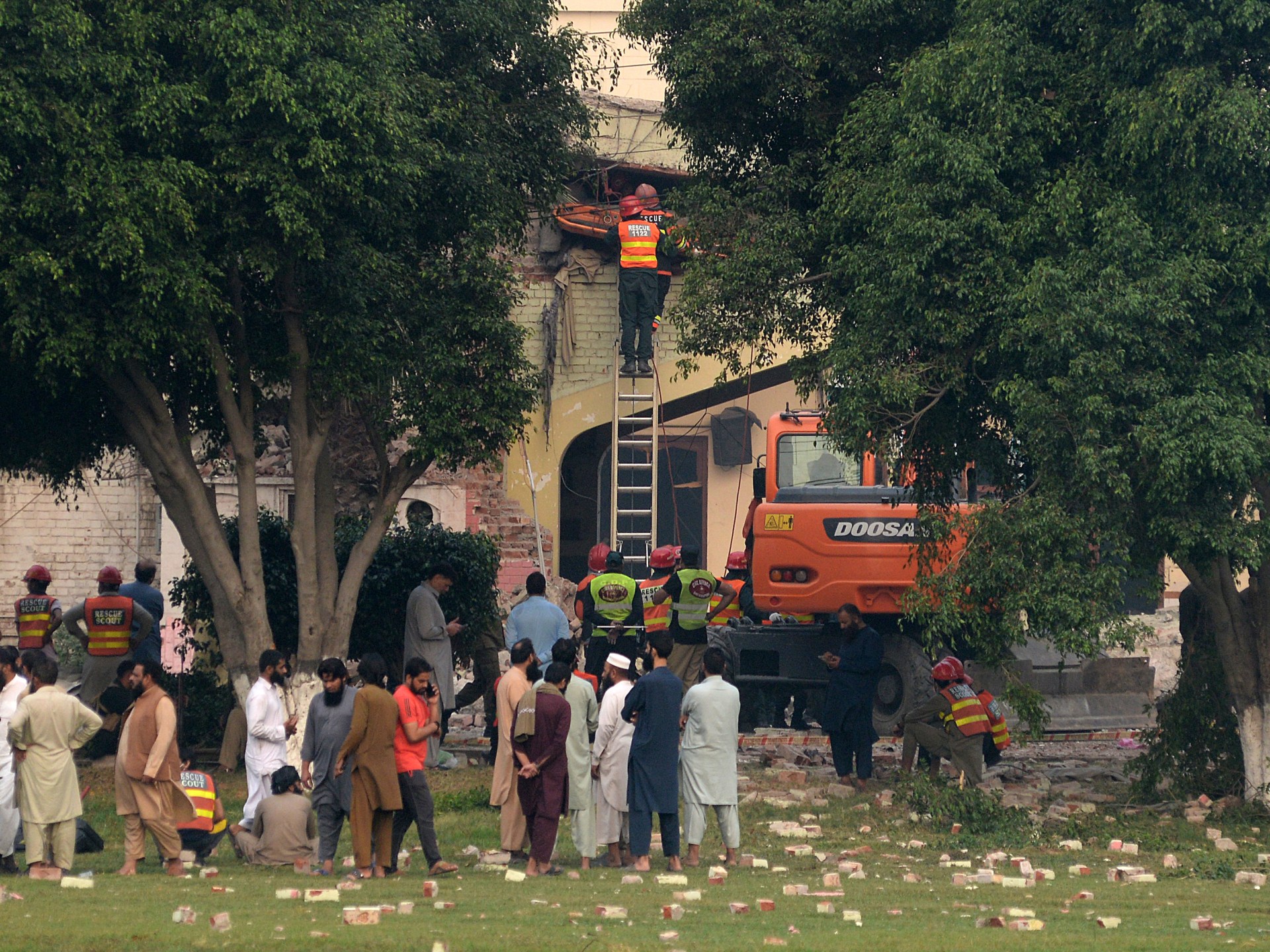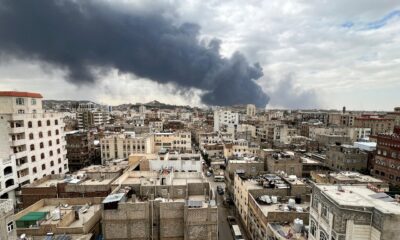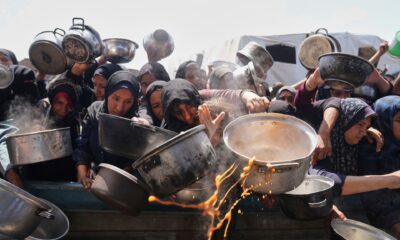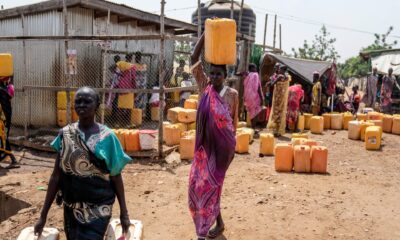Conflict Zones
How world leaders are reacting to India-Pakistan military strikes | Border Disputes News

Nations call for restraint as India launches ‘Operation Sindoor’, attacking several sites in Pakistan, which in response claims to down Indian jets.
India has launched ‘Operation Sindoor’, a military operation targeting multiple locations in Pakistan and Pakistan-administered Kashmir that New Delhi alleges are “terrorist” training sites.
In response, Islamabad claimed it struck Indian army positions and shot down several warplanes, calling India’s strikes “an act of war”.
At least 26 people have been killed overnight in Pakistan and 10 in Indian-administered Kashmir, officials said.
This is what global leaders are saying about the escalation in hostilities between the nuclear-armed neighbours:
US President Donald Trump
“It’s a shame. Just heard about it. I guess people knew something was going to happen based on a little bit of the past. They’ve been fighting for a long time. They’ve been fighting for many, many decades. I hope it ends very quickly,” Trump said.
US Secretary of State Marco Rubio
The US administration said it was closely following the military escalation in South Asia.
“I am monitoring the situation between India and Pakistan closely. I echo @POTUS’s comments earlier today that this hopefully ends quickly and will continue to engage both Indian and Pakistani leadership towards a peaceful resolution,” Rubio posted on X.
I am monitoring the situation between India and Pakistan closely. I echo @POTUS’s comments earlier today that this hopefully ends quickly and will continue to engage both Indian and Pakistani leadership towards a peaceful resolution.
— Secretary Marco Rubio (@SecRubio) May 6, 2025
Spokesperson for UN Secretary-General Antonio Guterres
“The Secretary-General is very concerned about the Indian military operations across the Line of Control and international border. He calls for maximum military restraint from both countries,” a spokesperson for Guterres said in a statement.
“The world cannot afford a military confrontation between India and Pakistan,” it added.
French Foreign Minister
France has called on India and Pakistan to show restraint as the worst violence in two decades flared between the two nuclear-armed neighbours.
“We understand India’s desire to protect itself against the scourge of terrorism, but we obviously call on both India and Pakistan to exercise restraint to avoid escalation and, of course, to protect civilians,” Foreign Minister Jean-Noel Barrot said in an interview on TF1 television.
Japan Chief Cabinet Secretary Yoshimasa Hayashi
“In regard to the terrorist act that occurred in Kashmir on April 22, our country firmly condemns such acts of terrorism. Furthermore, we express strong concern that this situation may lead to further retaliatory exchanges and escalate into a full-scale military conflict.
“For the peace and stability of South Asia, we strongly urge both India and Pakistan to exercise restraint and stabilize the situation through dialogue,” Hayashi stated.
United Arab Emirates Foreign Minister
UAE Foreign Minister and Deputy Prime Minister Abdullah bin Sultan bin Zayed Al Nahyan called on India and Pakistan to show restraint, reduce tensions and prevent further escalation, according to a government statement.
“His Highness reaffirmed that diplomacy and dialogue remain the most effective means of peacefully resolving crises, and achieving the shared aspirations of nations for peace, stability, and prosperity,” the statement said.
Israel’s ambassador to India
Israel’s ambassador to India, Reuven Azar, said in a statement that Israel supports India’s right to self-defence. Posting on X, Azar said, “Israel supports India’s right for self defense. Terrorists should know there’s no place to hide from their heinous crimes against the innocent. #OperationSindoor.”
Israel supports India’s right for self defense. Terrorists should know there’s no place to hide from their heinous crimes against the innocent. #OperationSindoor
— 🇮🇱 Reuven Azar (@ReuvenAzar) May 7, 2025
Conflict Zones
Information war: Are India or Pakistan telling the truth about attacks? | India-Pakistan Tensions News

Competing press briefings. Divergent claims. And conflicting narratives.
As Indian attacks on Pakistan and Pakistan-administered Kashmir early in the morning on May 7 pulled the nuclear-armed neighbours to the brink of a potential military conflict, a parallel war quickly broke out — over information.
Within hours of the Indian strikes, authorities on both sides put out claims and counterclaims that have been amplified on social media as each country tries to control the narrative in its favour.
Five Indian jets were downed, Pakistan said, for instance. India has yet to respond to the claim: Officials who requested anonymity confirmed that three jets had crashed in Indian-administered Kashmir, but did not confirm whether they were Indian or Pakistani planes.
Here is a look at what both India and Pakistan have claimed so far — and how they have a history of competing narratives that often allow them to each assert wins over the other to their respective domestic audiences, while making independent verification of the truth harder.
What was targeted?
India said its forces hit “terrorist infrastructure” at nine sites in response to last month’s deadly shooting attack in Pahalgam in India-administered Kashmir. India blamed Pakistan for the Pahalgam attack, in which 26 civilians were killed. Islamabad denied the charges and asked India to provide evidence to back up its claims.
Pakistan said Indian forces on Wednesday hit six cities in Pakistan and Pakistan-administered Kashmir and a health centre.
Pakistan said civilians were killed, including a three-year-old girl.
But Indian Defence Minister Rajnath Singh said his forces did not harm civilians. In a news briefing, Indian air force Wing Commander Vyomika Singh said the strikes led to “no collateral damage” and had been conducted through “precision capability”.

Did Indian forces hoist a white flag at LoC?
The Pakistani government on its official X account said Indian soldiers raised a white flag, a common symbol of surrender, at a military post along the Line of Control, the de facto border that divides Indian-administered and Pakistan-administered Kashmir.
Pakistani Minister for Information and Broadcasting Attaullah Tarar echoed the claim on his X account, posting: “First they fled from the investigation, now they fled from the field.”
Indian authorities have yet to formally address the claim, but as India and Pakistan are not officially at war, it is unclear why New Delhi might feel the need to surrender.
Were warplanes downed? How many? And who did they belong to?
Pakistan military spokesperson Ahmed Sharif Chaudhry said five Indian jets had been downed, all within Indian territory, with planes from neither side crossing into the other’s airspace.
According to Indian security sources who spoke to Al Jazeera, three fighter jets have been downed inside Indian-controlled territory. However, it was not clear whether they were Pakistani or Indian warplanes.
While there has been no comment from the federal government, the Indian embassy in China dismissed claims of Indian jets being brought down in Chinese state media outlet Global Times as “disinformation”.

History of conflicting claims
Previous escalations between India and Pakistan have also generated conflicting claims and accusations, often leaving observers to ponder which account — if either — reflects the truth.
In February 2019, Indian forces said they had hit a large number of “JeM [Jaish-e-Muhammad] terrorists, trainers, senior commanders and groups of jihadis” in Balakot in Pakistan-administered Kashmir, weeks after a suicide attack killed 40 members of the security forces in India-administered Kashmir’s Pulwama.
Formed in 2000, JeM has carried out numerous attacks on Indian forces in India-administered Kashmir. Both India and Pakistan have designated the armed group as a “terrorist organisation”, but its leader Masood Azhar has been allowed to operate in Pakistan. His current whereabouts are unknown.
Pakistan, which denied having a role in the Pulwama attack, said the Indian air attacks in 2019 hit an uninhabited forest.
Similarly, in 2016, Pakistan rejected India’s claims of “surgical strikes” against “terrorist units” on its territory after an attack on an Indian army base that killed 18 soldiers in Uri in India-administered Kashmir.
The Pakistani military called the claims an “illusion” and said India had engaged in nothing more than “cross-border fire, … which is an existential phenomenon”.
Conflict Zones
Operation Sindoor: What’s the significance of India’s Pakistan targets? | India-Pakistan Tensions News

The Indian military launched multiple missile attacks targeting sites in Pakistan and Pakistan-administered Kashmir early on Wednesday in an attack it called Operation Sindoor. The Pakistani military claims to have retaliated, shooting down multiple Indian military planes.
At least 26 Pakistanis have been killed in the six targeted cities, according to Lieutenant Ahmed Sharif Chaudhry, the director general of the Inter-Services Public Relations (ISPR) media wing of Pakistan’s military. India says it struck nine sites.
But what’s the significance of the cities and sites that India attacked? And what are India and Pakistan saying about those strikes? And why did India launch these attacks in the first place?
Why did India strike Pakistan?
The missiles were India’s response to the deadly April 22 attack on tourists in Indian-administered Kashmir in Pahalgam, during which 26 men were killed.
An armed group called The Resistance Front (TRF), which demands independence for Kashmir, claimed responsibility for the Pahalgam attack. India claims that the TRF is an offshoot of Pakistan-based armed group, the Lashkar-e-Taiba (LeT). Islamabad has denied its involvement in the Pahalgam attack and has asked for a neutral investigation into the incident.
However, since the attack, India has suspended its participation in the Indus Waters Treaty that Pakistan relies on for its water supply. Pakistan has responded by threatening to suspend its participation in the Simla Agreement, a pact signed in 1972 following the Indo-Pakistan War. Both countries have also scaled back their diplomatic ties, and each has expelled the other’s citizens.
How has India justified the attacks?
India claims it hit “terrorist infrastructure”, targeting organisations including the LeT and Jaish-e-Muhammad (JeM), an armed group based in Pakistan which claimed responsibility for a suicide bombing in February 2019, which killed 40 Indian paramilitary soldiers in Pulwama in Indian-administered Kashmir.
In a briefing on Wednesday, Indian Foreign Secretary Vikram Misri insisted that the missile strikes “focused on dismantling the terrorist infrastructure and disabling terrorists likely to be sent across to India”.
Joining Misri in the briefing, Indian military officials Colonel Sofiya Qureshi and Wing Commander Vyomika Singh detailed the operation. Five of the nine sites that India hit, they said, were in Pakistan-administered Kashmir. The remaining four were in Punjab – in Bahawalpur, Muridke, Shakar Garh and a village near Sialkot.
During the briefing, the Indian military showed a map marking out what it claimed were 21 “terrorist camps” in Pakistan and Pakistan-administered Kashmir. Al Jazeera has not been able to independently verify the claims of either the Indian or Pakistani militaries.

What has Pakistan said about the sites attacked?
Chaudhry of the ISPR described the Indian strikes as an “unprovoked attack, targeting innocent people”. He indicated that India had launched a total of 24 strikes across six locations in Pakistan and Pakistan-administered Kashmir.
Chaudhry said at least 26 civilians, including women and children, had been killed, and at least 46 people were injured. He claimed mosques and residential areas were targeted, killing and injuring civilians.

What’s the significance of the sites targeted by India?
The Indian missile strikes represent the most extensive attacks on Pakistani soil outside the four wars that the nuclear-armed neighbours have fought. They also mark the first time since the war of 1971 that India has attacked Punjab, Pakistan’s most populated province and historical and economic hub.
Unlike previous aerial attacks by India in Pakistan or in Pakistan-administered Kashmir, some of these strikes targeted large population centres. Muridke is next to Lahore, Pakistan’s second-most populous city. Sialkot and Bahawalpur are major cities, too.
But many of the sites chosen as targets by India also hold specific strategic importance, at least from New Delhi’s perspective. Here’s a breakdown:
Muridke, Punjab
Muridke is a city in Punjab’s Sheikhupura District, peppered with totems of historical memory from the Mughal, Mauryan and Gupta eras.
Chaudhry said a mosque named Masjid Ummul Qura was targeted with four strikes. One man was killed and one man was injured as a result. Two people have been missing from this location, Chaudhry said, adding that surrounding residential quarters have also been damaged in these attacks.
But the town, according to India and much of the international community, also hosts the headquarters of the Jamat-ud-Dawa, a charity organisation that New Delhi insists is a front for the LeT.
On Wednesday, India’s Qureshi claimed that Indian missiles struck the LeT’s Markaz Taiba camp in Muridke. The Indian army claimed that key perpetrators of the 2008 Mumbai attack – including Ajmal Kasab, the sole gunman who was captured alive after that assault on India’s financial capital – were trained at that camp.
Meanwhile, images emerging from Muridke showed rescuers searching for victims amid the debris of a damaged government health and education complex.
Bahawalpur, Punjab
Chaudhry said that four Indian missiles struck Ahmedpur Sharqia, a town near Bahawalpur, targeting a mosque named Masjid Subhan, which was destroyed in the attack. He said that at least five people were killed in the attack, including two men, two women, and a three-year-old girl. Additionally, he said, 31 people were injured – 25 men and six women. He added that four “residential quarters”, where civilian families were living, were damaged.
But Qureshi said India had hit the headquarters of the JeM, called Markaz Subhanallah. India described the site as a hub for “recruitment, training and indoctrination”.
Muzaffarabad, Pakistan-administered Kashmir
Muzaffarabad is the capital city of Pakistan-administered Kashmir, located at the confluence of the Jhelum and Neelum rivers. Muzaffarabad is sustained by its cottage industry ecosystem, including furniture making, wood carving, garment making and embroidery work, according to the State Bank of Pakistan.
Chaudhry said that a mosque called Masjid e Bilal was hit in Muzaffarabad, and a “young girl was injured”.
But Qureshi said India hit a LeT training centre, Sawai Nala camp in Muzaffarabad, 30km (19 miles) away from the Line of Control (LoC), the de facto border that separates Indian-administered and Pakistan-administered Kashmir. She claimed that those responsible for multiple attacks, including the April 22 Pahalgam killings, were trained at this camp.
The Indian military officials also said they attacked a Jaish-e-Muhammad “staging area”, the Syedna Bilal camp in Muzaffarabad. A staging area refers to a place where people, vehicles and equipment are assembled and readied before being assigned a mission.
Kotli, Pakistan-administered Kashmir
Kotli is a city along the Poonch river and is an agricultural and tourist hub.
Chaudhry said a mosque named Masjid Abbas was targeted in Kotli. A 16-year-old girl and an 18-year-old boy were killed. At least two other people were injured, he added.
Qureshi, however, said that India hit a LeT base, Gulpur camp, about 30km (19 miles) away from the LoC. The Indian army added that it also struck what it called the Abbas camp in Kotli, 13km (8 miles) away from the LoC, where Qureshi said up to 15 “terrorists” could be trained at a time.
Qureshi said India has also hit Mehmoona Joya, which she described as a facility of the Hizbul Mujahideen (HuM), a rebel group based in Indian-administered Kashmir. The HuM was founded by separatist leader Muhammad Ahsan Dar in September 1989, with a pro-Pakistan ideology, calling for India to leave the parts of Kashmir that it administers.
Bhimber, Pakistan-administered Kashmir
Qureshi claimed India struck what India called the Barnala camp in Bhimber, about 9km (5.6 miles) away from the LoC. She claimed that fighters were trained in using weapons, improvised explosive devices (IEDs) and in jungle survival at this camp.
Pakistani officials had not mentioned Bhimber as the site of any of the Indian attacks by late Wednesday evening. However, Bhimber is just south of Kotli, so it is unclear whether a missile strike on Bhimber is being counted by Pakistan as among the attacks on Kotli.
Sialkot, Punjab
Sialkot is one of Pakistan’s most important industrial centres for the manufacture of surgical items, sporting goods and leather products.
Chaudhry said that a village north of Sialkot called Kotli Loharan was targeted in two strikes. One of these strikes misfired and did not explode, while the other landed in an open field, resulting in no damage, Chaudhry said.
India’s Qureshi and Singh, however, claimed that India had struck what they called the Sarjal camp in Sialkot. They claimed this was the training centre for those responsible for the killing of four police officers in March this year in Indian-administered Kashmir.
Shakar Garh, Punjab
Chaudhry said Shakar Garh was targeted with two strikes and reported “minor damage” to a “small hospital, a dispensary”.
However, Indian military officials have not mentioned Shakar Garh among the places targeted in the May 7 strikes.
Conflict Zones
‘High risks’: Indian attacks in Pakistan raise fears of wider conflict | India-Pakistan Tensions News

New Delhi, India – In the first hours of Wednesday, Indian armed forces said they struck nine locations in Pakistan and Pakistan-administered Kashmir, where residents woke up to loud explosions, as the nuclear-armed rivals edged to the precipice of a full-blown military conflict.
New Delhi said its missiles precisely targeted “terrorist infrastructure” across the border while demonstrating “considerable restraint”. The Indian Army, in a statement, said the attack was “non-escalatory in nature” and pointed out that Pakistani military facilities were deliberately not targeted.
Yet a fuming Islamabad claimed that Indian attacks in six Pakistani cities killed at least 8 civilians, including two children. Pakistani ministers also claimed that the country’s air force had shot down several Indian military jets.
India’s missile attacks – called Operation Sindoor – were the country’s response to the deadly April 22 attack in Indian-administered-Kashmir’s Pahalgam, in which 26 people were killed. India blamed Pakistan for that attack, while Islamabad denied it had any role. Since then, Indian armed forces have combed the forests near Pahalgam, arrested more than 2,000 people and raided homes in an unsuccessful manhunt for the gunmen who fled after shooting tourists dead.
The May 7 attacks on Pakistan and Pakistan-administered Kashmir offer Indian Prime Minister Narendra Modi a chance to bolster his strongman image at home, analysts told Al Jazeera. But the Indian government’s emphasis on signalling “restraint” points to an attempt to balance that domestic message with a different narrative for the rest of the world.
Amid it all stands an undisputed fact, say analysts: India’s attacks have raised the risks of the region spiralling into a wider conflict.
‘Concerning development’
The Indian attacks were the most expansive since the neighbours last fought a full-fledged war in 1971 – a time when neither had nuclear weapons at their disposal as they do now.
Of the six places that Indian missiles struck, two are cities – Muzaffarabad and Kotli – in Pakistan-administered Kashmir. The region of Kashmir – one of the world’s most militarised zones – is claimed in full, and ruled in parts, by India and Pakistan, who have fought three wars over it.
But the other four targets that India struck are in Punjab -Bahawalpur, Muridke, Sialkot and Shakar Garh. Among them, Bahawalpur falls in southern Punjab province, facing the Thar desert, while Muridke is just next to Lahore, Pakistan’s second-largest city, with a population of 14 million.
The Indian military has not hit Punjab, Pakistan’s economic heartland that is also home to 60 percent of the country’s population, since 1971.
Indian air attacks since then have mostly targeted remote parts of Pakistan or Pakistan-administered Kashmir. Six years ago, Indian jets fired missiles at Balakot in Pakistan’s Khyber Pakhtunkhwa province, after a suicide bomber killed at least 40 Indian paramilitary soldiers in Indian-administered Kashmir.
These May 7 attacks are different. Lahore, next to Muridke, is close to the Indian border and is Pakistan’s second-most populous city, pointed out Sumantra Bose, an Indian political scientist whose work focuses on the intersection of nationalism and conflict in South Asia. Bahawalpur, in southern Punjab, is also a key city.
The Indian government claims that it strategically hit only “terror infrastructure”. And in a post on X, the Indian army said, “Justice is served.”
But Bose said the attacks were “a very concerning development”.
“Surgically targeted precision strikes do not change the fact that there have been these large explosions in major Pakistani population centres,” said Bose. “This is proper Pakistan, not Pakistan-administered-Kashmir [claimed by India].”
‘Likely domestic dividends’ for Modi
Two days after the Pahalgam attack, Modi said, in an address at an election rally in the poll-bound state of Bihar, that his government would “identify, trace, and punish every terrorist and their backers”, promising to pursue them “to the ends of the Earth”.
Following the attack, India suspended its participation in the Indus Waters Treaty (IWT) that Pakistan counts on for its water security. Islamabad has threatened to walk out of past peace deals. Both nations have also expelled each other’s diplomats, military attaches and hundreds of civilians.
But there has been growing domestic pressure on the Modi government, said political analysts, to attack Pakistan after the Pahalgam attack.
“There was a high level of pressure on Modi to respond with muscle,” said Michael Kugelman, director of the South Asia Institute at the Wilson Center in Washington, DC. “It would have been unfathomable for India’s government not to respond militarily, given Modi’s self-projection as an administrator who is strong, confident, decisive, determined to hit back hard against terrorism.”
Rasheed Kidwai, a political analyst in New Delhi, said the Pahalgam attack had “emotionally” driven a desire in the Indian public for retribution against the attackers and those seen as their enablers. And Modi, with his image as someone who delivers on national security, was catering to those sentiments. “India is retaliating in a precise manner,” Kidwai said.
In many ways, the May 7 Indian missile attacks were in keeping with the script New Delhi had outlined since the April 22 killings in Pahalgam, said Praveen Donthi, a senior analyst at the International Crisis Group.
Like Kugelman and Kidwai, Donthi referred to the image that the Modi government has created for itself domestically. “This moment aligns with India’s self-projection as a strong security state with zero tolerance for terrorism, primarily directed against Pakistan, and Modi’s strongman persona. It was a self-created litmus test that the Indian government needed to ace,” he told Al Jazeera. “There are likely domestic dividends for it.”
But, Donthi warned, the Indian attack on Pakistan also “portends future risks”.
Kugelman agreed, describing the Wednesday missile attacks as “the most intense levels of Indian military actions we’ve seen in Pakistan for quite a few years now”.
What’s next?
Back in Pakistan, as officials pledge retaliation against what they call India’s “act of war”, Kugelman said the situation suits Islamabad’s military leadership, too.
The attacks “will actually bolster Pakistan’s current regime because the military leadership can use these attacks to rally the public around the military leadership,” he said. “The military has tended to derive its legitimacy from this idea that it needs to protect the country from the threat posed by India. We could see a rally around the flag effect [in Pakistan].”
Since the Indian attack, both armies have traded heavy artillery and gunfire across the de facto border in disputed Kashmir. Currently, Kugelman said, there is “a pretty strong possibility of escalation, given that both countries have nuclear weapons”.
“The more hostilities that are used through conventional military force under a nuclear umbrella, the higher the risk of nuclear escalation.
“We’re not there,” he noted. “But certainly, the escalation risks are quite high.”
-

 Lifestyle2 days ago
Lifestyle2 days agoDiplomats in Zimbabwe embrace local culture in a lively cooking contest
-

 Middle East1 day ago
Middle East1 day agoIsrael hits Yemen’s Houthi-controlled Sanaa airport in tit-for-tat attack | Houthis News
-

 Lifestyle1 day ago
Lifestyle1 day agoOne Tech Tip: Skype shut down for good, but users still have these alternatives
-

 Middle East2 days ago
Middle East2 days agoNo sense in Gaza ceasefire talks amid Israel’s ‘hunger war’: Hamas | Israel-Palestine conflict News
-

 Conflict Zones2 days ago
Conflict Zones2 days ago‘We are suffering’: Displaced families bear burden of South Sudan conflict | Humanitarian Crises News
-

 Sports2 days ago
Sports2 days agoLindsey Vonn says she proved to herself and her doubters that ‘I deserve to be here’ after skiing return
-

 Middle East2 days ago
Middle East2 days agoExplosions, huge fire in Sudanese city of Port Sudan | Sudan war News
-

 Sports2 days ago
Sports2 days agoZhao Xintong becomes China’s first world snooker champion after comeback from ban




